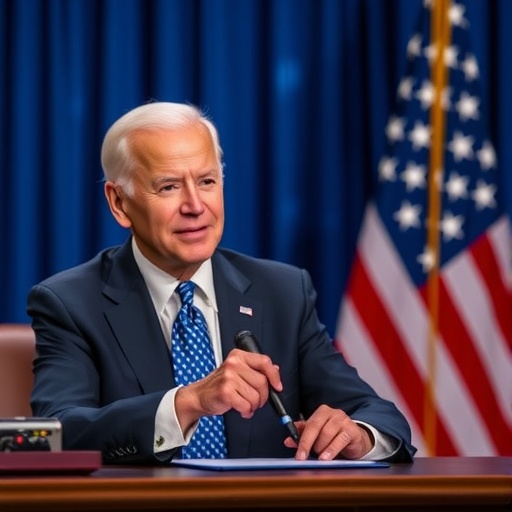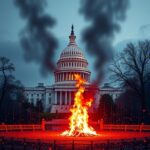Biden Signs Groundbreaking Executive Order: Revolutionizing AI regulation and Data Privacy in the US
In a landmark move that could reshape the future of technology in America, President Joe Biden has signed a sweeping executive order aimed at imposing comprehensive AI regulation while bolstering data privacy protections for millions of consumers. Announced from the White House on a crisp autumn morning, this directive marks the most ambitious federal intervention in artificial intelligence to date, signaling a new era of technology policy that prioritizes safety, equity, and individual rights over unchecked innovation.
- Key Mandates: From AI Safety Standards to Privacy Overhauls
- Silicon Valley’s Split Response: Enthusiasm Meets Skepticism
- Addressing AI’s Ethical Quandaries: Bias, Equity, and Accountability
- Global Ripples: How US Policy Influences Worldwide Tech Standards
- Path Forward: Implementation Timeline and Innovation Horizons
The order, titled “Advancing Responsible Artificial Intelligence and Safeguarding Data Privacy,” comes at a time when AI technologies are infiltrating every corner of daily life—from personalized healthcare recommendations to autonomous vehicles—yet raising alarms about biases, surveillance, and data breaches. With AI projected to add $15.7 trillion to the global economy by 2030 according to PwC estimates, the White House emphasized that without guardrails, these advancements could exacerbate inequalities and erode trust in digital systems. “This is not about stifling innovation; it’s about ensuring that AI serves all Americans, not just a select few,” Biden stated during the signing ceremony, his voice carrying the weight of a nation grappling with tech’s double-edged sword.
At its core, the executive order directs federal agencies to develop and enforce guidelines that address the ethical deployment of AI. This includes mandatory risk assessments for high-stakes applications like facial recognition and hiring algorithms, where historical data shows biases against marginalized groups—such as a 2019 study by the National Institute of Standards and Technology revealing that certain AI systems misidentify Black and Asian faces up to 100 times more often than white faces. The order also mandates transparency requirements, compelling developers to disclose training data sources and algorithmic decision-making processes, a direct response to calls from civil rights organizations like the ACLU, which has long warned of AI’s potential to perpetuate systemic discrimination.
Key Mandates: From AI Safety Standards to Privacy Overhauls
Diving deeper into the executive order‘s framework, the document outlines a multi-pronged approach to AI regulation that spans development, deployment, and oversight. One of the most immediate directives tasks the Department of Commerce and the National Institute of Standards and Technology (NIST) with creating a national AI safety institute within the next six months. This body will establish voluntary but enforceable standards for AI systems, focusing on robustness against adversarial attacks—scenarios where malicious inputs could trick AI into catastrophic errors, as seen in recent incidents involving self-driving cars misinterpreting road signs.
Statistics underscore the urgency: A 2023 report from the AI Now Institute found that over 70% of large-scale AI models lack basic safeguards against misinformation, contributing to the spread of deepfakes during elections. Under the new technology policy, federal contractors using AI must now undergo annual audits, with non-compliance risking contract revocation—a provision that could affect giants like Palantir and IBM, which hold billions in government deals.
On the data privacy front, the order strengthens existing frameworks like the California Consumer Privacy Act (CCPA) by extending federal oversight to non-state actors. It prohibits the sale of personal data for AI training without explicit consent, a measure aimed at curbing the practices of data brokers who amassed over 300 million consumer profiles last year, per a Federal Trade Commission investigation. “Consumers deserve control over their digital footprints,” said White House tech advisor Tim Wu, echoing sentiments from privacy advocates who point to the 2018 Cambridge Analytica scandal as a cautionary tale of data weaponization.
Further, the executive order introduces interoperability standards for data sharing among federal agencies, ensuring that AI tools enhance services like disaster response without compromising individual privacy. For instance, during the COVID-19 pandemic, contact-tracing apps raised privacy fears; now, similar initiatives must incorporate privacy-by-design principles, including end-to-end encryption and data minimization techniques.
Silicon Valley’s Split Response: Enthusiasm Meets Skepticism
The tech industry’s reaction to this White House initiative has been a tapestry of cautious optimism and outright pushback, highlighting the tension between regulation and rapid innovation. Leaders from OpenAI, the creators of ChatGPT, welcomed the order as a “necessary evolution” in AI regulation. CEO Sam Altman tweeted shortly after the announcement: “We’re committed to building AI that benefits humanity. This framework aligns with our safety research and will help us iterate responsibly.” OpenAI has already invested $100 million in alignment efforts, and the company stands to gain from clearer federal guidelines that could preempt a patchwork of state laws.
Contrast that with sharper critiques from other corners. Elon Musk, whose xAI and Tesla ventures heavily rely on AI, labeled the order “overreach that could hobble American competitiveness against China.” In a post on X (formerly Twitter), Musk argued that stringent data privacy rules might slow down data collection essential for training autonomous systems, citing Tesla’s need for vast datasets from its 4 million vehicles. Similarly, Amazon’s Andy Jassy expressed concerns in a memo to employees, noting that the executive order could increase compliance costs by up to 20% for cloud services like AWS, which powers much of the world’s AI infrastructure.
Not all feedback is negative; smaller firms and startups see opportunity. Anthropic, a rival to OpenAI focused on safe AI, praised the move, with co-founder Dario Amodei stating in an interview: “This levels the playing field, preventing big tech from monopolizing AI without accountability.” Venture capital data supports this: Investments in ethical AI startups surged 45% in 2023, per Crunchbase, suggesting that robust technology policy could spur innovation in compliant niches like privacy-preserving machine learning.
Industry groups like the Information Technology and Innovation Foundation (ITIF) have called for balance, warning in a policy brief that excessive AI regulation might drive talent and investment overseas. Yet, a survey of 500 tech executives by Deloitte revealed that 62% support federal standards to avoid regulatory fragmentation, underscoring a desire for predictability amid the current landscape of 50 state-level privacy bills.
Addressing AI’s Ethical Quandaries: Bias, Equity, and Accountability
Central to the executive order is a commitment to mitigating AI’s ethical pitfalls, particularly in areas where bias and inequity loom large. The directive requires all federally funded AI projects to conduct equity impact assessments, evaluating how algorithms affect underserved communities. This builds on findings from a 2022 White House report that highlighted how AI in criminal justice systems, like COMPAS software, falsely flagged Black defendants as high-risk at twice the rate of white ones.
To enforce accountability, the order establishes a new interagency council led by the Office of Science and Technology Policy, tasked with monitoring AI deployments across sectors. Penalties for violations could include fines up to $100 million, modeled after GDPR in Europe, which has already fined Meta $1.3 billion for data mishandling. “We’re drawing a line in the sand,” said council chair Alondra Nelson. “AI must be a tool for justice, not division.”
In education and healthcare, where AI promises transformative gains, the technology policy mandates human oversight for critical decisions. For example, AI-driven grading tools must allow appeals, addressing concerns from teachers’ unions about opaque algorithms disadvantaging English language learners. Healthcare applications, such as diagnostic AI from Google DeepMind, will need to disclose accuracy rates across demographics, countering a 2021 study in The Lancet that found AI outperforming doctors in 87% of cases but underperforming for minority patients.
Environmental considerations also factor in, with the order directing the EPA to assess AI’s carbon footprint—training a single large model can emit as much CO2 as five cars over their lifetimes, per University of Massachusetts research. This holistic approach aims to ensure AI regulation doesn’t just protect people but also the planet.
Global Ripples: How US Policy Influences Worldwide Tech Standards
Beyond domestic borders, this White House executive order positions the US as a leader in shaping global AI regulation, potentially influencing international accords. With the EU’s AI Act set to enforce tiered risk categories by 2024, Biden’s framework aligns on high-risk categorizations but emphasizes innovation-friendly flexibility. Diplomats note that this could facilitate bilateral agreements, such as with the UK, which is developing its own AI safety summit outcomes.
China’s state-driven AI ambitions, including its 2023 guidelines prioritizing national security over privacy, make the US order a strategic counterweight. “By setting high bars for data privacy, we’re not just protecting our citizens; we’re exporting American values,” remarked Secretary of State Antony Blinken in a briefing. Trade implications are significant: US firms could gain advantages in markets demanding compliant tech, while non-compliant exports face tariffs under new WTO rules.
Experts predict ripple effects in developing nations, where AI adoption is accelerating without safeguards. The World Bank estimates AI could boost GDP in low-income countries by 7%, but only if ethical standards prevent exploitation. Initiatives like the US-led Partnership on AI, now bolstered by the order, will offer technical assistance to allies, fostering a coalition against unregulated AI proliferation.
Challenges persist, however. Implementation will require congressional funding—estimated at $500 million annually—and coordination among 15+ agencies. Critics, including the Heritage Foundation, argue that executive actions bypass legislative checks, potentially leading to legal challenges akin to those against Biden’s student debt relief.
Path Forward: Implementation Timeline and Innovation Horizons
As the ink dries on this transformative executive order, the road ahead involves a structured rollout to embed AI regulation and data privacy into the fabric of American technology policy. Within 90 days, agencies must submit implementation plans, with public comment periods to incorporate stakeholder input—a nod to transparency that could refine the guidelines based on real-world feedback.
Looking to the future, the order paves the way for potential legislation, such as the bipartisan AI Foundation Act, which could codify these standards into law. Industry watchers anticipate a boom in compliance tech, with startups like those in the Privacy Tech ecosystem projected to raise $2 billion in 2024. For consumers, enhanced protections mean greater control—tools like AI-powered privacy dashboards could become standard, empowering users to audit data usage.
Ultimately, this initiative challenges the tech sector to innovate responsibly, balancing the thrill of breakthroughs with the gravity of their societal impact. As AI evolves from science fiction to everyday reality, Biden’s vision offers a blueprint for a future where technology amplifies human potential without compromising core freedoms. The coming years will test whether this White House gamble yields a safer, fairer digital age—or sparks the very innovation it seeks to guide.









